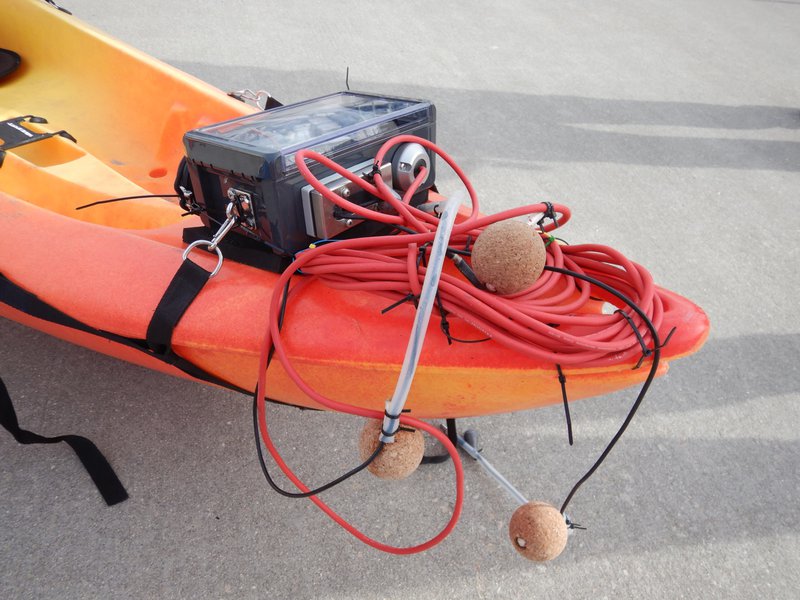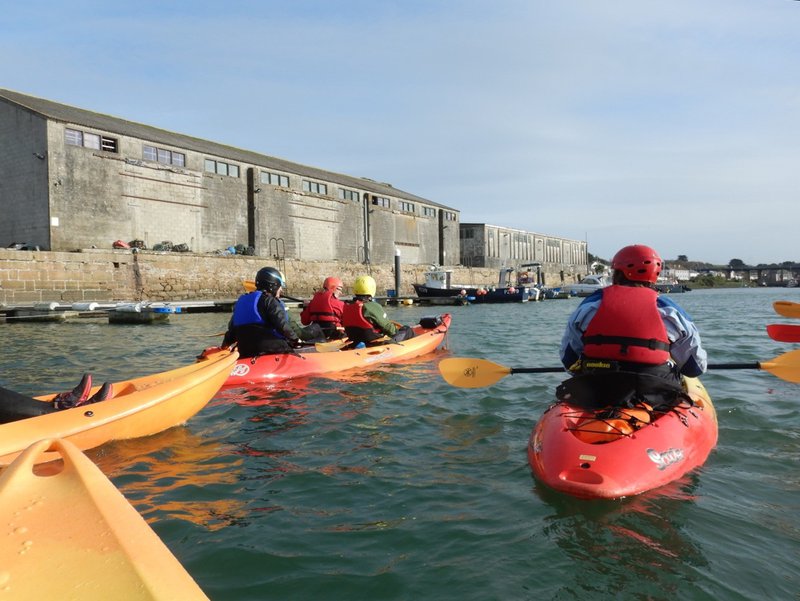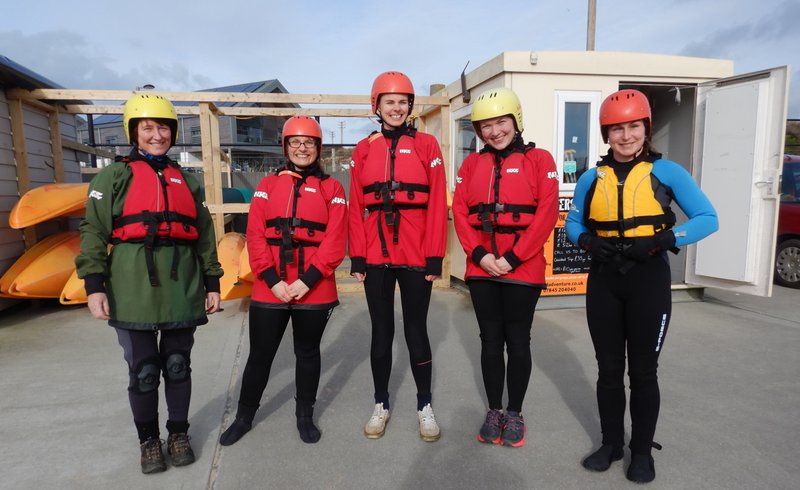Karin Johansson's Sonic Kayak MSc placement
Posted Feb. 28, 2019 by Karin JohanssonThis post is a summary of Karin Johansson's MSc placement at FoAM Kernow on the Sonic Kayak project. The Sonic Kayaks are currently being modified for use for people with visual impairments. Karin helped develop and test an evaluation approach that can be used in future to look at whether the Sonic Kayaks offer wellbeing benefits to the paddlers.
At the end of January, I joined FoAM Kernow to complete a work placement for my master’s degree in Environmental Science at the University of Exeter. As part of my placement I spent two days at Hayle Harbour testing the Sonic Kayak with Lizard Adventure and researchers at the European Centre for Environment and Human Health (ECEHH). The Sonic Kayak is both a musical instrument and a citizen science project that allows the paddler to explore the underwater environment through sound. During a session the paddler hears real-time temperature sonifications from the temperature sensors and any underwater sounds detected by the hydrophone. Using the GPS, location-specific sounds can also be loaded onto maps and triggered as different zones are entered.

For the test days, we used one Sonic Kayak system between about 10 of us. As we paddled around Hayle Harbour we heard temperature sonifications, some underwater noise detected by the hydrophone and spoken information about the heritage of Hayle as we entered different zones.
The purpose of these test days was (a) to test an interview which investigates if the system brings well-being benefits to its users, (b) to get some general feedback on the project and (c) to see if we could survive without Amber and Dave there to help if anything went wrong (which, thankfully, we did!!).
Testing the interview
Along with Jo Garrett, Ian Mason and Claire Eatock from ECEHH, I helped create a series of three interviews designed to investigate if the Sonic Kayak system brings well-being benefits to its users due to the extension of their senses. The first interview (T1) was designed to be conducted just before the activity and consisted of questions about the participants previous experience of the coast and watersports and how they are feeling about taking part in the Sonic Kayak activity. The second interview (T2) was designed to be conducted straight after the activity and aimed to capture their initial impressions and feelings about the experience, what they enjoyed, what they would change, would they do the activity again, etc. The third and final interview (T3) was designed to be conducted about a month after the activity to investigate any lasting impact the activity may have had. T3 has not yet been tested.
Here is some general feedback on the process of conducting the interviews.
- Overall, the interviews were reasonable in length: T1 took about 6 – 8 minutes and T2 took about 4 – 6 minutes.
- The interviewees indicated that they would rather be interviewed before they got into their wetsuits and after they had changed back into their clothes.
- Having the interview questions set up as an online form on a tablet helped the interviewer navigate the questions easily.
- Most of the questions worked well and people were free to say as much or as little as they liked. Some questions may benefit from being broken down to make them easier to answer – e.g. the question ‘what sensations were you aware of’ may be better to break up into ‘what could you hear’, ‘what could you smell’, ‘any movement sensations’? However, it is important here to be sensitive of impairments the interviewee may have.
- It would be a good idea, especially for people with visual impairments, to have a chance to feel the system – i.e. touch the temperature sensors, tap the hydrophone etc.
- We recorded the interviews and used an automatic transcription service but found that the transcriptions contained too many mistakes to be useful and didn’t distinguish between people.
- On day one the tablets would time out and lock whilst an interviewee was speaking which interfered with the flow of the interview. We removed the screen time out on the second day which was much better.
- Another thing that came up which needs some thought is how to tell participants about Sonic Kayak. Our current thoughts are that a short video clip or podcast would be good to send to them before the activity. Firstly, this would give them an idea of what they are doing and what to expect which may relieve any nerves. Secondly, this should make the interviews less biased as everyone should have received the same information about the project.
- The interviews we conducted assumed that the interview method does not impact the results. However, it is highly likely that it does. Wellbeing could be impacted by taking part in the interview as some people may be really nervous to talk to someone and answer questions and some may feel like they are being tested. This issue can be solved by including extra questions such as ‘how do you feel about doing this interview?’.

Outcomes of interviews and general comments
Overall the interviews revealed that people were feeling very positive and excited about the Sonic Kayak project. Those that didn’t know much about the system before they took part in the activity were really interested in experiencing the Sonic Kayak and learning more about it. Below are some comments from the interviewees:
“I’m excited about it, I think it is a good experience.”
“Feeling very positive about the project. Glad to be here.”
“It’s novel and its very different to anything else that anyone I know has experienced on the water. Bringing in unique technology really makes it a different experience.”
Most of the interviewees said that they really enjoyed hearing the facts about Hayle as they paddled around. Everyone said that they would like to do the activity again and everyone reported that they would recommend it to a friend.
The main issue with the activity was the volume of the spoken information. It was very difficult for the people not on the Sonic Kayak to hear the spoken information. This was an issue because of the type of speaker that was being used – causing it to sound quite ‘tinny’. Originally much higher quality speakers were being used but they were not waterproof and the risk of losing them is not worth it. This problem can be solved by replacing the speaker with a better quality, waterproof one – although this would increase the cost of the system. Another possibility is to try balancing the sound files and also re-recording the spoken parts. We also tested having the system at the back of the kayak and at the front. We found that the system was more secure at the back but volume wise it is better at the front of the kayak.
A further problem relating to volume was that the temperature sonification played during the spoken parts which made it even harder to hear. A suggestion here would be to make the temperature sonification stop when the spoken parts are playing. However, this could be easily fixed by balancing the sounds relative to each other.
One interviewee reported not feeling in control of their journey because they didn’t have the Sonic Kayak system on their kayak. They found the experience was therefore less enjoyable because they didn’t feel like they could set their own pace. The obvious solution for this would to be able to have more systems so more people can have their own system on the kayak. Another possible solution to investigate is finding a way to have a speaker on each kayak (maybe using Bluetooth).
Some interviewees were also disappointed that they didn't hear any underwater sounds from the hydrophone during the activity. Either there simply was no underwater sounds to hear or the sound needs to be amplified or balanced.

Summary
Overall the test days were a success as we managed to get everything working smoothly without Amber and Dave. We discovered aspects that need some work on the Sonic Kayak system and were able to fine tune the interview questions and process.
Created: 15 Jul 2021 / Updated: 15 Jul 2021



